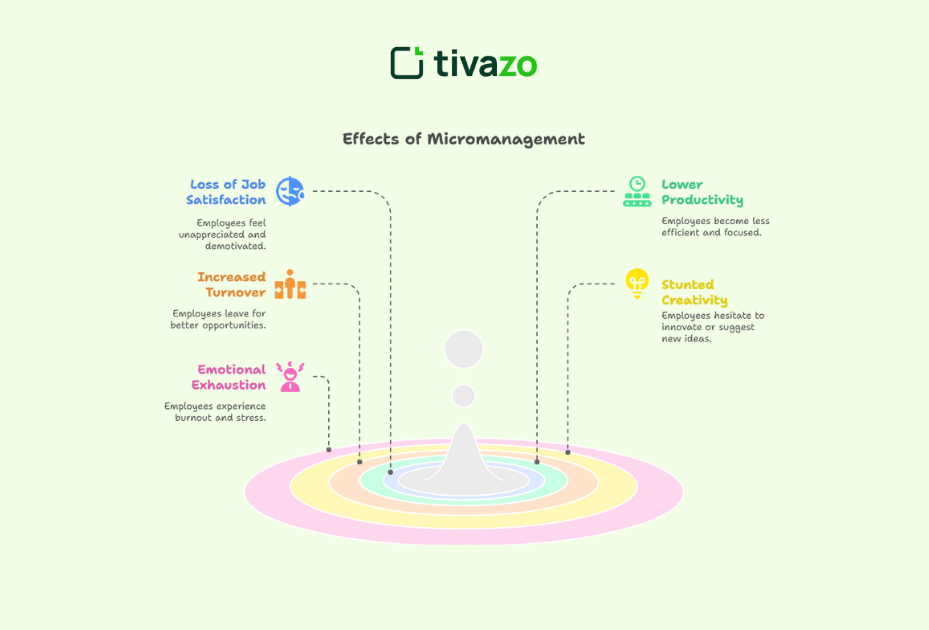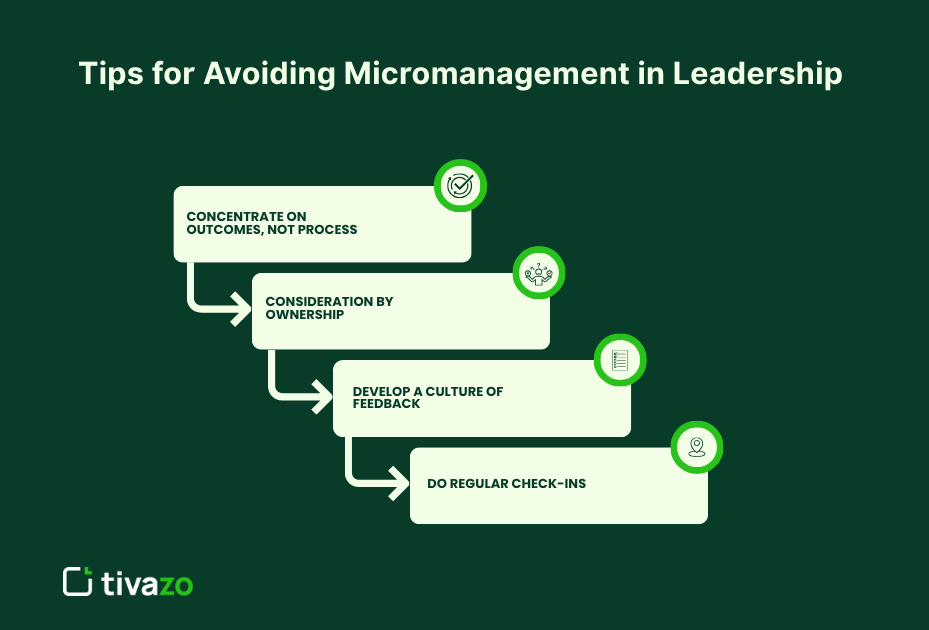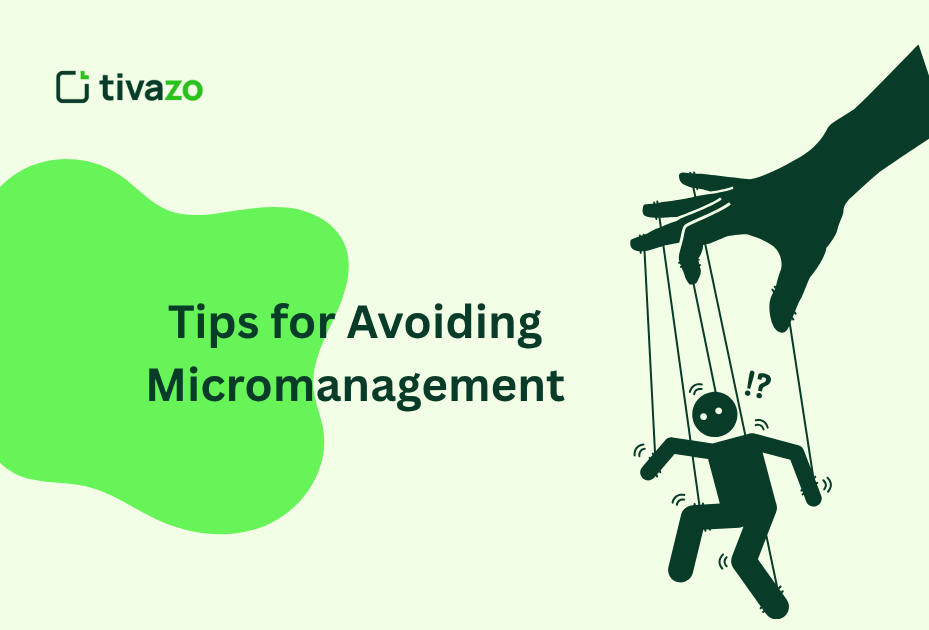Micromanagement is a productivity, morale, and innovation killer that is not easily spoken about. The excessive involvement and supervision of the work of the team by the leaders overregulate the creative activities and promote distrust. Preventing micromanagement is not only an organizational leadership approach; it is a cultural change that fosters independence and responsibility. Here in this blog, we will look at what micromanaging is, its impacts, and how to adopt fair delegation and trust to create a stronger, empowered team. Here, you will also get to know how not to micromanage your team and learn some of the best strategies for avoiding micromanagement as a leader.
What Is Micromanagement?
Micromanagement is a style in which a leader keeps a close eye on employees’ or subordinates’ work. It is usually in the worst place due to a lack of mutual trust or fear of mishandling, or inability to delegate. Although it can be out of compliments, micromanaging is mostly effective at fostering undesirable results in the workplace.
The Problem with Micromanagement in Leadership
In the case of micromanagement, leadership is usually instigated by the erroneous assumption that continuous supervision is the only way to ensure success. Leaders can sometimes believe that to be able to control and prevent mistakes, one needs to be involved in all minor aspects. Nevertheless, this solution tends to demonstrate a level of untrustworthiness towards the other members of the team and poisons the atmosphere within the work setting.
Instead of the workforce increasing output, micromanagement lowers the morale, stifles creativity, and kills initiative. It becomes an indicator to employees that their skills and judgment is not valued and this brings about disengagement and poor performance.
Some of the typical signs of micromanagement of leadership are:
- Always keeping tabs on what the employees are doing, even where there was no necessity
- Preventing individual decisions by the team members
- Becoming excessively involved in the usual or small concerns
- Taking too many approvals for minor activities
The habits oppress independence and deny employees the capacity to solve issues. By micromanaging, the leaders miss the point of strategic planning and innovation. This leads to an organization-inspired leadership that restrains individual and group abilities.
The initial phase of change is understanding that you are micromanaging your employees. The leaders need to be more self-aware, develop a trusting mindset, and allow the employees to own their work. They can build a culture of accountability, confidence, and high performance only then.
Effects of Micromanagement on Employees

The consequences of micromanagement on employees are permanent and immense. This might appear as a good temporary strategy in keeping control; however, this leads to a toxic atmosphere, which negatively affects morale, decreases productivity, and negatively impacts team cohesion. The following are the effects of micromanagement on employee performance and well-being in the workplace, on the whole:
1. Losing Job Satisfaction
Decreasing employee satisfaction is one of the first indicators of micromanaged workplace. By constantly questioning or watching the team members very closely, they start believing that they are not trusted, valued, or respected. This brings in disengagement and a decline in motivation. Those employees who are not even given an opportunity to take ownership of their work soon lose their interest and enthusiasm towards work.
2. Lower Productivity
The end of micromanagement might be to give better results; it normally produces the reverse. Unnecessary interruptions, too strong supervision, and approval kill a lot of time and brain energy. Employees give a lot of time to reporting on the work and not the work done. With the diminishing autonomy, the initiative diminishes as well and is followed by delays and inefficiencies throughout the board.
3. Increased Turnover
Another devastating repercussion of micromanaging is that it affects retention. Employees who perform well, especially, are likely to abandon a workplace where their services cannot be trusted and where they are allowed to exercise their skills at will. The best talent values autonomy and empowerment, and in case they feel that they are constrained, they will go to organizations that embrace independence and empowerment of the leadership.
4. Stunted Creativity
Fear of fault drives an employee in a micromanaged environment to the point where he/she does not want to be innovative. The fear of being criticized or interfered with causes employees to hesitate to share ideas or to implement new procedures by experimenting. This kills imagination and stops the organization from developing. This stiff atmosphere deters the capacity of company to evolve and develop over time.
5. Emotional Exhaustion and Burnout
Burnout is probably the worst of the effects. Chronic stress is brought about by the feelings of being coerced into achieving tough demands with a lack of independence or care. The condition in the micromanaged environment places employees on the edge to be anxious and overwhelmed, becoming emotionally exhausted. Eventually, this causes a higher absenteeism rate, low performance, and in the worst circumstances, it results in a total lack of interest in the job.
Delegation vs Micromanaging: Striking the Right Balance
Embracing proper delegation is one of the most effective strategies to use in order to prevent micromanaging the employees. Leaders should also know that delegation is not abdication, but it is empowerment.
Delegation Best Practices:
- Make the task and the expected outcome to be clear
- Allocate roles of competency and progression objectives
- Never give them instructions, but resources and support
- Believe in the process and give freedom
- Feedback should be provided at the end, not in the process
Delegation by the leaders not only clears out the time of the leaders, but it also creates more competent teams because the leaders will be in a position to nurture the teams. This results in a healthier workplace and innovation.
Workplace Autonomy and Trust
The opposite of micromanagement is building autonomy at the workplace. By making employees feel trusted, they will own their tasks, make improved judgments, and become confident.
Steps to Promote Autonomy:
1. Create Clear Expectations and Goals
Autonomy is not a synonym for not knowing where to go. Well-spelt out objectives and expectations provide the employees with a blueprint to success and the leeway to express themselves in implementing the objectives.
Employees feel empowered to contribute their creativity and expertise to yield results when they are given a clue of what results are required of them instead of being told how they are supposed to carry out all tasks and activities. Such transparency brings down uncertainties and creates confidence.
2. Give the Employees Freedom of Choice
Micromanaging is usually a result of the inflexible handling system of leaders. Rather, giving members of the team a choice as to which techniques, resources, and strategies to employ raises their motivation and productivity. Employees will acquire problem-solving skills and the aspect of responsibility, which will be of benefit to them on how to grow as well as the company to be successful, since employees are given flexibility on how to design their work style.
3. Promote Free Flow of Conversation Devoid of Interception
It is vital to promote an open culture of communication so that employees feel free to exchange new information on progress, challenges, and ideas without fear of immediate correction or micromanagement. Instead of commanding every move, it is important that a person in charge of the group listens and offers advice where required. Such a balance is what can be described as encouragement of mutual respect and stimulation of the sense of psychological safety in the team.
4. Recognition and Reward Initiative
It is best to celebrate the employees who take initiatives, and it encourages others to be the same because autonomy is a very important value. Rewards- Unofficial or official rewards, praise or recognition, whether verbal or nonverbal, encourage the employees to go the extra mile and perform more than as assigned to them. This practice assists in forming a positive feedback loop in which autonomy and accountability prosper.
5. Give Coaching, not Control
Leaders are expected to transform from directing or telling their employees what to do to coaching. Coaching probes, offers guidance, and assists the team members in the expansion of skills and judgment. It develops trust and ability that employees are ready to take up more duties on their own, and this is one of the most important advantages of not micromanaging at the workplace.
The advantages of not micromanaging at work include a higher satisfaction level in employees, better team performance, and the improvement of these efforts contributes as well.
Signs You’re Micromanaging Your Staff
Micromanagement is sometimes unconscious; most managers are poorly aware that they are trapped in this kind of control behavior. The most important step to positively change is the creation of self-awareness. Reflectively give yourself a moment and ask yourself the following questions to make a very sincere look at your leadership habits:
- Do I often request progress, which is unwarranted? Regular check-ins can be viewed as a lack of trust, thus interfering with the concentration of your team.
- Am I less ready to relinquish control of things or decisions? Micromanaging every small information constrains the development of your team as well as their autonomy.
- Do I tend to be distrustful of the decisions of others, even those capable of making those decisions? Such indecisiveness may bring about a cul-de-sac and demotivate entrepreneurship.
- Are my employees looking forward to my decision when it comes to trivial matters rather than independently resolving them? It means that you are over-managing your team when they find it necessary they ask your approval to do some small routines.
Ask yourself these questions and, in case you said “yes” even once, it is high time you reconsidered the strategy. By being aware of such behaviors, you can start the trail to get out of micromanaging to more enlivening leadership habits- one that builds trust, independence, and more robust team contributions.
Tips for Avoiding Micromanagement in Leadership

To avoid micromanaging, the leadership should first change the frame of reference, ceasing control to trusting. Not only does this change help you improve your relationship with your team, but it also results in better outcomes. These are some points to start with:
1. Concentrate on Outcomes, not Process
Your attitude towards each and every task being done should be changed to the end results you desire. Result-based measurement gives your team freedom to achieve the best method that suits them and their abilities. Such an attitude can promote creativity and problem-solving, minimize excessive control, and allow employees to own their jobs.
2. Consideration by Ownership
Allowing team members to take charge of the projects or become managers of tasks will make them feel that they own it and are accountable. Employees who feel empowered are more involved, motivated, and willing to give quality work. By taking a step back and allowing your team to lead you establish trust in your staff, and you are free to concentrate on strategic business.
3. Develop a Culture of Feedback
Seek to have an open and honest communication environment in your team, whereby feedback is taken positively as a means of development and not as criticism. Continuous learning and improvement can be achieved when employees are in a safe environment to share ideas and mistakes. A healthy feedback culture eliminates the fear, which is one of the major contributors to micromanagement, and provides an enabling environment where all individuals can shine.
4. Do Regular Check-ins
Provide a balance between autonomy and accountability through the creation of structure check-ins. Such a meeting gives a specific area where updates, questions, and instructions can be given, and not always to be found doing so. The frequent reviews assist in keeping up with the objectives and at the same time recognizing the self-reliance of workers to fill their gaps between links.
Strategies to Stop Micromanaging Employees
In case micromanaging has already become your main course of action, here are the ways to cease micromanaging employees and earn team trust back:
Establish boundaries and expectations: Develop what types of decisions your team can make on their own to minimize needless oversight.
Active listening: Active listening requires you to give attention to the ideas and issues that your team members are struggling with to strengthen the bond of mutual trust and demonstrate that you consider their ability to make decisions.
Begin with a small scale: Delegation of an action as a whole: assign a small task and do not interfere, until it is completed.
Cheer team victories: Especially when celebrating the achievements made by your team, you should encourage morale and emphasize their sense of ownership.
Think about your weekly leadership actions: Embark on a schedule of weekly examination of your actions so as to be aware of your micromanaging tendencies and determine to commit to alteration.
Avoiding Micromanagement in Remote Teams
It is also quite common that remote work settings make the urge to micromanage more pronounced, which is mostly due to the inability of leaders to see what their employees are doing. Still, the rules of efficient leadership are still the same, only more crucial in the virtual environment. These are the ways of preventing micromanagement within remote teams:
Trust is even more important: Since there is no possibility to control personnel directly, establishing and strengthening trust becomes the pillars of successful remote leadership.
Transparency: Project management tools such as Trello, Asana or Monday.com allow visibility on the process without frequent check-ups.
Don’t measure time online: Measure the amount of work completed and outcomes, not the hours online or busy.
Promote out-of-sync communication: Facilitate leniency in terms of time and method employees use to communicate to accommodate other schedules and working styles.
Leaders may consider the above strategies so that the remote workers on board feel equally empowered and trusted as their colleagues in the office, and motivation to manage themselves, and thereby enhance productivity, would be prevalent.
Benefits of Avoiding Micromanagement at Work
Greater Employee Retention and Satisfaction
Workers who perceive that they are trusted and are provided with freedoms to deal with their work on their own are usually happier and better motivated. They feel that they own the work and their input, and this increases engagement and decreases. This boost in job satisfaction results in greater retention rates, which saves the company the costs and disturbance that constant turnover brings.
Increased creativity and problem-solving
To stop innovation, micromanagement tends to instill fear on its employees so that they can be afraid of doing something wrong or experimenting. On the contrary, innovations thrive when employees are allowed to share ideas and do experiments. The teams will be more adaptable and inventive, and will respond to the challenges using new thinking, and ensure innovative solutions take the company in a different direction.
Greater bandwidth of Strategic Leadership
Getting rid of micromanaging, leaders can possess useful time and mental resources allowing them to think about the grand view and long-term prospects. They do not need to micromanage and therefore, they will be able to focus on strategy, vision, and growth opportunities that move the company to its objectives. This is a strategic focus that is much needed to sustain success.
A Conquered Company Culture
Trust and autonomy create a favorable culture in the workplace where employees feel cared about and have a sense of authority. This type of environment promotes teamwork, responsibility, and respect. This also makes the organization more adaptable to change or challenge, which is emphasized firmly through resilience to adjust to the change or challenge, which helps everyone.
Creating a Culture That Discourages Micromanagement
Behaviors are influenced by culture. Make autonomy and trust part of your organization to avoid micromanaging.
Recruitment based on Trust and Independence
The first thing is to hire people with intrinsic values and who exhibit self-motivation. The need to micromanage is also minimized by the fact that employees, such as those who are self-starters need little supervision. Recruitment of independence makes the first impression and helps to have a workforce that can operate well under responsibility.
Train Managers: Delegation and Coaching
Conduct leadership training on effective delegation and coaching skills, and not control. Managers who know how to learn to trust their teams, guide without interfering, and facilitate the development of their employees, enable the micromanagement practice not to be functional.
Reward Team Work Roles
Reward and recognize the leaders who exercise collaborative and empowering styles of leadership. When the focus on building trust and autonomy is rewarded by managers, it will solidify the same behaviors at every level of the organization and aid in the cultural change moving toward micromanagement.
Encourage Transparency Concepts on all Levels
Promote transparent communication and exposure to mission, performance, and obstacles between departments and groups. Transparency brings in the element of trust as it removes doubts and the subsequent need to put too much control on employees, enabling them to work with a level of confidence and direction toward common goals.
Conclusion: From Micromanagement to Empowerment
Micromanagement should not be a one-time solution. Being a leader, the change in approach to controlling to trusting not only changes the performance of your team but the whole culture of the workspace. Emphasize on good communication, delegation, and accountability and you know you and your employees will have a golden chance of success.
The quest begins with understanding and presses on with regular actions. Rid yourself of micromanaging and see how your team thrives as you learn ways to eliminate micromanaging employees and create a culture that rewards trust and self-control.
How do I stop being micromanaged?
Communicate with your manager, show reliability, and suggest regular check-ins to build trust.
. What is not micromanagement?
It’s supportive leadership, guiding without controlling, and allowing autonomy in how work is done.
Why is micromanaging not good?
It lowers morale, stifles creativity, and leads to burnout, harming team performance and growth.




